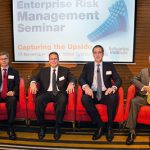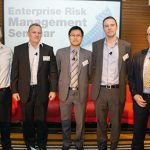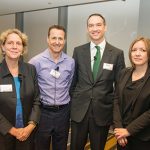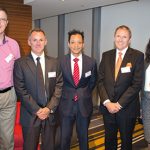
Enterprise Risk Management Seminar – Capturing the Upside
The sixth ERM Seminar was held at the Hilton Hotel in Sydney on Wednesday 19 November 2014. The seminar was opened by President Daniel Smith who commented that there were over 140 delegates this year, of which a quarter had also attended the General Insurance Seminar on the two days before.
Overall, the seminar had a very ‘hands on’ feel as most of the presenters were risk management practitioners (CROs, actuaries, analysts) and subject matter experts (subjects including climate change, emissions and environment, innovation, risk appetite statements). We also heard from stakeholders on their view of ERM in practice (CEOs and CROs).
The seminar format consisted of a keynote address followed by six plenary sessions. Each plenary session was independently chaired and included a panel discussion at the end during which questions could be asked by the audience either via SMS or the old fashioned microphone method – SMS questioning was by far the most popular option.

In the keynote address we heard from Howard Silby, President of Risk Management Association Australia (RMAA). Howard covered the six hot topics highlighted by RMAA members during 2014. These included strategic risk management, risk culture, regulatory impacts, rebranding of the risk profession and new engagement skills needed, operational risk and economic and market insights. When asked how far along the risk management journey we were in terms of ‘Capturing the Upside’, Howard said we were half way through but that resource constraints and cost pressures are resulting in less time to think. Risk functions need breathing space to do deep thinking and take a ‘balcony view’ of the risk and business landscape. If this doesn’t happen, Howard said there is a danger we don’t make the rest of the journey.
The first plenary discussed ‘Capturing the upside in Practice’. Scott Mackenzie (TAL CRO) said we need to overcome the stigma of RISK as a four letter word and suggested CROs be relabelled as ‘Chief Challenge Officers’. Mike Thornton (AMP CRO) suggested the Risk Function should aspire to be like the Apple iPhone – intuitive, easy to use and interact with. Mike also likened the Risk Function to a soccer team – you need to decide whether you’ll be all attack, mostly defenders with a lone striker grinding out a 1-0 win, or some other formation. During the Q&A session there was a lot of discussion on businesses needing to identify and own the risks associated with their strategic plan upfront, not use Risk as a filter after the plan has been set.
Plenary two covered ‘Stress Testing and Scenario Analysis’. The four speakers discussed the uses of stress testing and scenario analysis in the context of general insurance, health insurance, lenders mortgage insurance and reinsurance. Potential uses highlighted during the discussion included monitoring risk profiles relative to Risk Appetite Statements, business continuity planning, escalation of potential risks and exposures, internal model building and/or validation, reinsurance purchasing, resource planning, engagement of key stakeholders, and deeper dives on particular risk topics. Jeremy Waite educated the audience on the Feynman Algorithm, which can be used to solve any problem – first you write down the problem, then you think very hard, and lastly you write down the solution!
The third plenary session enlightened us on ‘Emerging Risk from Climate Change’. Professor Barbara Norman presented on a risk management approach to climate change. The major points Barbara made were that Australia is getting hotter and drier, and we do not have an adaptation strategy. Our current planning system is based on a static environment, not one that is changing significantly. Emma Herd talked about Westpac’s strategic response to climate change, including their three engagement themes – building resilience, sustainable cities and investing in the two degree economy (i.e. limiting temperature change to two degrees). Tim Andrews shared some of the work Finity has been doing on the impacts of climate change on the future of the insurance industry.
After lunch, plenary four discussed ‘Operational Risk – Value and Resilience in a World of Disruptive Change’. Heather Navid (TAL) highlighted some disruptive products and services including the internet, digital cameras, Uber and Zopa (peer to peer lending service). Heather also talked about how to develop resilience in a world of change – have a strong radar, get to know your customers, try stuff yourself, and be the disrupter. Tara Cahill then discussed the drivers of disruption in the banking industry which included new technology, new entrants, changing customer expectations, regulation, economic conditions and heightened geo-political risks. Finally, Kieran McKenna (Cuscal CRO) introduced us to the ideas of futurist Richard Watson. He also challenged actuaries to question how they can pull levers to positively influence future experience, not just analyse the past.
Plenary five covered ‘Risk Appetite’. David Creaven and Stephen Britt spoke on behalf of the Life and GI Risk Appetite Working Parties respectively. David talked us through the ‘Risk Appetite Framework’– an approach to establishing, communicating and monitoring your risk appetite. He also proposed definitions of risk tolerances (constraints on business outputs) and risk limits (constraints on business inputs). Stephen expanded on the attributes and gave examples of risk limits and tolerances, including an interesting ‘non-insurance’ example involving teenagers being home on time. Dean Saunders (Westpac) then talked about risk appetites from a banking perspective. He posed the question “Why have a risk appetite?”, then went on to discuss current trends and key success factors in the risk appetite space.
The last plenary of the day discussed ‘Stakeholder Views of ERM in Practice’. Jim Minto (TAL) highlighted the differences between a CRO and Appointed Actuary. Damien Mu (AIA) presented a maturity map of the risk function as a three state model – efficient fundamentals, insightful partnership and value enhancement. He also discussed the challenges for ERM – behavioural economics (getting customers to behave better), thinking in terms of ‘today, tomorrow and the day after’, finding the opportunities and avoiding complacency. Shaun Dooley (NAB) gave a banking perspective on ERM. He talked about Risk Management’s role in rebuilding trust and confidence in banks. Conor O’Dowd (Genworth) talked about capturing the essence of ERM – integrating risk thinking into business decision making. During the Q&A session two memorable questions were:
- what are the core capabilities of a CRO?; and
- what keeps you up at night?

This article only scratches the surface in terms of the rich content of the ERM Seminar. I’d encourage everyone to check out the presentations, including audio and video recordings, on the Actuaries Institute website. You can also read what tweeters were saying by searching #2014ERM or @ActuariesInst on Twitter.
A huge thank you to the presenters and chairs for their input, and the Organising Committee and Actuaries Institute staff for putting on a great seminar. Thanks also to the event sponsor, Milliman, and supporting partners.
CPD: Actuaries Institute Members can claim two CPD points for every hour of reading articles on Actuaries Digital.












